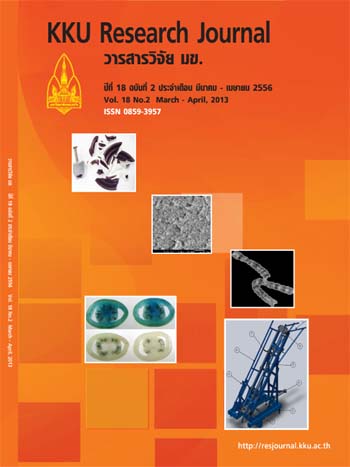Combined convective and radiative heat transfer on transpiration cooling system in Al-Co open-celled foam having PPI of 20
Main Article Content
Abstract
One-dimensional transpiration cooling system in open-celled foam has been conducted experimentally and numerically to investigate the heat transfer characteristics of combined convection and radiation. The Alumina–Cordierite (Al-Co) open-cell foam having porosity of 0.875 and pores per inch (PPI) of 20 was employed. The upper surface of porous plate was heated by the heat flux of incoming radiation (qRx,f) varying from 0.97 - 16.59 kW/m2 whereas air injection velocity (uf) fed into the lower surface was varied from 0.364 - 1.274 m/s, and was then rearranged as Reynolds number (Re). For the report of the results in the present study, two efficiencies including of temperature (hT) and conversion efficiency (hC) were presented. The hT increased rapidly with the air injection velocity (Re). It was then saturated and had a constant value at Re higher than 15. For the result of hC, it was decreased slightly with increasing of qRx,f and uf (Re). The numerical predictions also agreed with experimental data very well.
Article Details
References
[2] Choi SH, Scotti SJ, Song KD and Ries H. Transpiring cooling of a scram-jet engine combustion chamber: NASA (US); 1997. 8 p. Report No.: NASA AIAAA-97-2576.
[3] Glass DE, Dilley AD and Kelly HN. Numerical analysis of convection/ transpiration cooling. AIAA J Spacecraft Rockets. 2001; 38(1): 15–20.
[4] Bayley FJ and Turner AB. The heat transfer performance of porous gas turbine blades. Aeronautical Journal. 1968; 72: 1087–1094.
[5] Bayley FJ and Turner AB. Transpiration cooled turbines. Journal Proceeding of the Institution of Mechanical Engineering with turbine. 1970; 185(1): 943-956.
[6] Duwez P and Wheeler HL. Experimental study of cooling by injection of a fluid through a porous material. Journal of Aeronautical Sciences. 1948; 15: 509 – 521.
[7] Andrews GE and Asere A. Transpiration cooling of gas turbine combustion chamber walls. Institute of Chemical Engineering Symposium Series. 1984; 86: 1047-1056.
[8] Fu X, Viskanta R and Gore JP. Measurement and correlation of volumetric heat transfercoefficients. Experimental and Thermal and Fluid Science. 1988; 17(4): 285-293.
[9] Kubota H. Thermal response of a transpiration-cooled system in a radiative and convective Environment. Transaction of the ASME: Journal of Heat Transfer. 1977; 99: 628 – 633.
[10] Eckert ERG and Cho HH. Transition from transpiration to film cooling. Int J Heat Mass Transfer. 1994; 37 (suppl 1): 3–8.
[11] Wolfersdorf JV. Effect of coolant side heat transfer on transpiration. Heat Mass Transfer. 2005; 41:.327-337.
[12] Andoh YH and Lips B. Prediction of porous walls thermal protection by effusion or transpiration cooling. An analytical approach. Applied Thermal Energy. 2003; 23(15): 1947-1958.
[13] Jiang P-X, Yu L, Sun J-G and Wang J. Experimental and numerical investigation of convection heat transfer in transpiration cooling. Applied Thermal Engineering. 2004; 24 (8-9): 1271-1289.
[14] Kamiuto K. Thermal characteristics of transpiration cooling system using open-cellular porous materials in a radiative environment. 2005; 7: 58-96.
[15] Ogushi T, Chiba H, Tane M and Nakajima H. Cellular and Porous Materials. Ochsner A, Murch GE and Lemon M JS, editor. Wiley-VCH Verlag GmbH & Co. KGaA; 2008.
[16] Krittacom B. Studies on Thermal Characteristics of Open-Cellular Porous Burners [Ph.D. Thesis]. Oita, Japan: Oita University; 2009.
[17] Kamiuto K, Saito S and Ito K. Numerical model for combined conductive and radiative heat transfer in annular packed beds. Numerical Heat Transfer, Part A. 1993; 23: 433-443.
[18] Krittacom B and Amatachaya P. Comparison of radiative heat transfer equation in porous materials solving by the equation of formal solution and the P1 approximation equation. Engineering Journal of Siam University. 2008; 9(1): 20-30. Thai.


